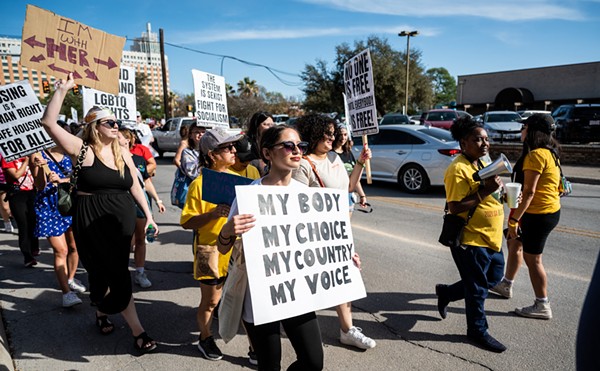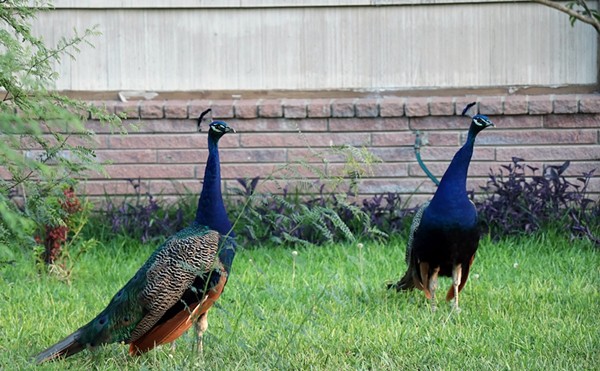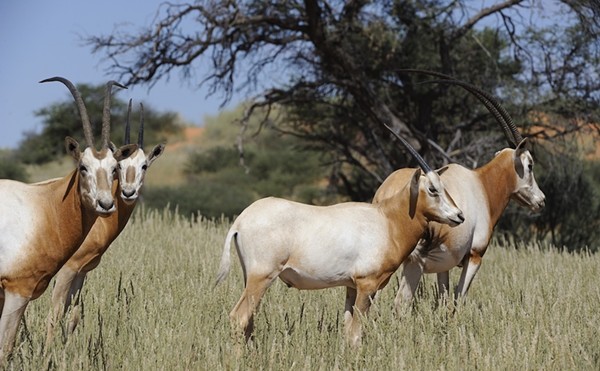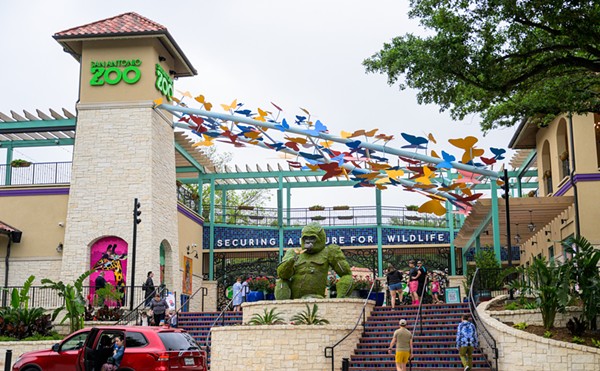Recent shows like "Figure and Illusion," "Media Lab," "Welcome to the Monkey House, " and the current exhibition, "Sana Sana Colita de Rana" have impressed me with their diversity, depth and humor. If this space in the back-alley of Blue Star isn't on your First Friday radar, it should be. And while I haven't cottoned to every individual piece of art I've seen there, I always stagger out of there, towards the marimba-sounding windchimes on somebody's nearby condo-porch, lost in a bewildered, meditative haze.
"Sana Sana Colita de Rana" translates roughly( and weirdly) as "heal, heal, little tail of the frog," and it's the first line in a Spanish kids' rhyme:
|
Spanish |
English |
|---|---|
|
Sana, sana, |
Heal, heal, |
|
colita de rana, |
little tail of the frog, |
|
Si no sanas hoy, |
If you don't heal today, |
|
sanarás mañana. |
you'll heal tomorrow. |
It's the Spanish language "kiss the boo-boo and make it better" song, something crooned by parents as they band-aid a skinned knee. The UTSA show is subtitled "Artists Influenced by La Cultura," and curator Ricky Armendariz has gathered edgy, genre-bending works by five painters, a video artist, a creatrix of exquisite modern papel picado, and a mixed-media/fabric magician, all their efforts steeped in the searing, high-octane spirits of South Texas.
Issues addressed include la Frontera, the re-Latinization of our country (and bodies), ethnocentric taboos, xenophobic fears (including internalized ones), and the daily rigors of work. Man, it's hard to write about the socio-culture of an art show without making it sound tired and academic, and this show isn't either of those things--it jumps out at you.
The show's tone is often comic-melancholic, as in Ian Tyler Ibarra's 2005 video loop "Tripa Love," in which he explores the 2004 Bexar County Mad Cow ban on tripas. The vid includes interviews with local health officials, food-cart vendors, and a lonely performative walk through Fiesta of a sad hombre (the artist himself, I'm guessing?) wearing a placard which reads WILL WORK FOR TRIPAS. The videography is often offhandedly beautiful (and the music is fantastic, and I'm dying to know what it was. Anybody know?)
And who knew the tripe wars could be so poignant? It's a surprisingly loaded topic. As one concerned vendor points out, the Mad Cow disease would effect all beefy parts--why were tripas singled out for castigation? ...I think we know why.
(Mr. Ibarra probably already knows this, but: tripas are legal again. I called the taqueria known for its delicious tacos de tripa, Piedras Negras de Noche at 1312 Laredo St., (210) 227-7777, to make sure.)
Meanwhile Kathleen Trenchard's papel picado works are both strong graphically strong and tender, celebrating in an almost photojournalistic way the details of beauty salons, bootmakers, dim sum, and driving a pickup, and evince both deep respect and whimsy without being kitschy or sentimental.
Donna Huanca's mixed-media fabric pieces embrace collage and mythology in surprising ways, whether in depicting idea-haunted border landscape in "Ciudad Juarez," or depicting a mindblowingly detailed, fascinatingly post-racial MesoAmerican goddess in "Pachamama."
Haydee Victoria Suescum's group of 16 small-scale paintings are unapologetically pretty, simple, and feminine, which doesn't diminish their power or appeal. Objects such as steam irons and ironing boards, stand fans and portraits of men and women, have both an iconic and an intimate feeling.
I have a major, embarrassing cucaracha phobia, which was wickedly tweaked by Francisco Delgado's clever, impassioned painting "Los Dos Panchas: Forgive Me Richard Florida For I Know Not What I Do." He depicts two enormous, Kafka-esque insects tenderly holding, um, hands against a threatening sky, the whole composition starkly reminiscent of Kahlo's "Las Dos Fridas." Both drink from coconuts and one wears a Barbie head. Richard Florida, btw, is the author of The Rise of the Creative Class. A banner hovers above the couple, reading in semi-graffiti wildstyle, "CARAMEL MACCHIATO." Confused yet? Despite the sheer number of allusions and variables here, the painting behaves like a cohesive, highly trenchant visual essay about the buying and selling of culture and identity.
Los Supersonicos (aka Francisco Zamora and Carlos Frésquez, whose sculptural, mixed media on wood panel pieces are also part of the show ) are responsible for two trippy-ass, deeply disturbing Acrylic paintings on canvas in the back room. "Hay Infeccion aka Eye Infection," depicts Latino archetypes--the boxer, the indio dancer, and a weeping eye. And "Doble Jesus aka YosoY," is a bewildering visual palindrome of, well, double Jesuses.
It's vastly entertaining, humorously disquieting show. I'm pretty sure I came out of the UTSA Satellite Space googly-eyed pero bien sanada.


















